热修复 笔记 第三部分 优化篇
Posted xzj_2013
tags:
篇首语:本文由小常识网(cha138.com)小编为大家整理,主要介绍了热修复 笔记 第三部分 优化篇相关的知识,希望对你有一定的参考价值。
热修复的pre-verify问题原理分析
上一篇实战的时候遗留了一个问题
在android4.4运行时出现了这样的一个崩溃:
java.lang.IllegalAccessError: Class ref in pre-verified class resolved to unexpected implementation
那么这是个什么错误呢?
直接翻译:一个被标为pre-verify的class引用了一个ref类,这个ref类被发现不是期待的实现方式
问题原因的简单介绍
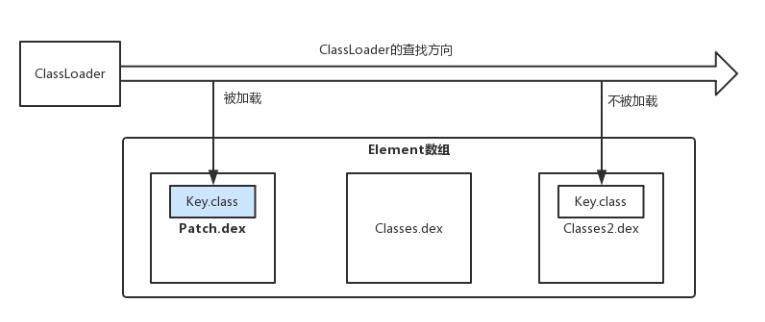
回顾下上篇的修复原理,以及我们的实战,我们是将Utils以及调用它的Activity放在同一个dex下,且只调用了同一个Dex下的类,这也就是问题出现的原因。
如果MainActivity类中只引用了:Utils类。当打包dex时, MainActivity与Utils都在classes.dex中,则MainActivity类被标记为 CLASS_ISPREVERIFIED。
如果使用补丁包中的Utils类取代出现bug的Utils,则会导致MainActivity与其引用的Utils不在同一个Dex,但MainActivity已经被打上标记,此时出现冲突。导致校验失败!

问题原因的源码分析:
我们去看一下异常抛出的位置以及如何调用到这个位置:
通过字符串搜索,我们在/dalvik/vm/oo/Resolve.cpp这个类中发现了这个异常的输出,就在dvmResolveClass方法中:
/*
36 * Find the class corresponding to "classIdx", which maps to a class name
37 * string. It might be in the same DEX file as "referrer", in a different
38 * DEX file, generated by a class loader, or generated by the VM (e.g.
39 * array classes).
40 *
41 * Because the DexTypeId is associated with the referring class' DEX file,
42 * we may have to resolve the same class more than once if it's referred
43 * to from classes in multiple DEX files. This is a necessary property for
44 * DEX files associated with different class loaders.
45 *
46 * We cache a copy of the lookup in the DexFile's "resolved class" table,
47 * so future references to "classIdx" are faster.
48 *
49 * Note that "referrer" may be in the process of being linked.
50 *
51 * Traditional VMs might do access checks here, but in Dalvik the class
52 * "constant pool" is shared between all classes in the DEX file. We rely
53 * on the verifier to do the checks for us.
54 *
55 * Does not initialize the class.
56 *
57 * "fromUnverifiedConstant" should only be set if this call is the direct
58 * result of executing a "const-class" or "instance-of" instruction, which
59 * use class constants not resolved by the bytecode verifier.
60 *
61 * Returns NULL with an exception raised on failure.
62 */
63ClassObject* dvmResolveClass(const ClassObject* referrer, u4 classIdx,
64 bool fromUnverifiedConstant)
65
66 DvmDex* pDvmDex = referrer->pDvmDex;
67 ClassObject* resClass;
68 const char* className;
69
70 /*
71 * Check the table first -- this gets called from the other "resolve"
72 * methods.
73 */
74 resClass = dvmDexGetResolvedClass(pDvmDex, classIdx);
75 if (resClass != NULL)
76 return resClass;
77
78 LOGVV("--- resolving class %u (referrer=%s cl=%p)",
79 classIdx, referrer->descriptor, referrer->classLoader);
80
81 /*
82 * Class hasn't been loaded yet, or is in the process of being loaded
83 * and initialized now. Try to get a copy. If we find one, put the
84 * pointer in the DexTypeId. There isn't a race condition here --
85 * 32-bit writes are guaranteed atomic on all target platforms. Worst
86 * case we have two threads storing the same value.
87 *
88 * If this is an array class, we'll generate it here.
89 */
90 className = dexStringByTypeIdx(pDvmDex->pDexFile, classIdx);
91 if (className[0] != '\\0' && className[1] == '\\0')
92 /* primitive type */
93 resClass = dvmFindPrimitiveClass(className[0]);
94 else
95 resClass = dvmFindClassNoInit(className, referrer->classLoader);
96
97
98 if (resClass != NULL)
99 /*
100 * If the referrer was pre-verified, the resolved class must come
101 * from the same DEX or from a bootstrap class. The pre-verifier
102 * makes assumptions that could be invalidated by a wacky class
103 * loader. (See the notes at the top of oo/Class.c.)
104 *
105 * The verifier does *not* fail a class for using a const-class
106 * or instance-of instruction referring to an unresolveable class,
107 * because the result of the instruction is simply a Class object
108 * or boolean -- there's no need to resolve the class object during
109 * verification. Instance field and virtual method accesses can
110 * break dangerously if we get the wrong class, but const-class and
111 * instance-of are only interesting at execution time. So, if we
112 * we got here as part of executing one of the "unverified class"
113 * instructions, we skip the additional check.
114 *
115 * Ditto for class references from annotations and exception
116 * handler lists.
117 */
118 if (!fromUnverifiedConstant &&
119 IS_CLASS_FLAG_SET(referrer, CLASS_ISPREVERIFIED))
120
121 ClassObject* resClassCheck = resClass;
122 if (dvmIsArrayClass(resClassCheck))
123 resClassCheck = resClassCheck->elementClass;
124
125 if (referrer->pDvmDex != resClassCheck->pDvmDex &&
126 resClassCheck->classLoader != NULL)
127
128 ALOGW("Class resolved by unexpected DEX:"
129 " %s(%p):%p ref [%s] %s(%p):%p",
130 referrer->descriptor, referrer->classLoader,
131 referrer->pDvmDex,
132 resClass->descriptor, resClassCheck->descriptor,
133 resClassCheck->classLoader, resClassCheck->pDvmDex);
134 ALOGW("(%s had used a different %s during pre-verification)",
135 referrer->descriptor, resClass->descriptor);
136 dvmThrowIllegalAccessError(
137 "Class ref in pre-verified class resolved to unexpected "
138 "implementation");
139 return NULL;
140
141
142
143 LOGVV("##### +ResolveClass(%s): referrer=%s dex=%p ldr=%p ref=%d",
144 resClass->descriptor, referrer->descriptor, referrer->pDvmDex,
145 referrer->classLoader, classIdx);
146
147 /*
148 * Add what we found to the list so we can skip the class search
149 * next time through.
150 *
151 * TODO: should we be doing this when fromUnverifiedConstant==true?
152 * (see comments at top of oo/Class.c)
153 */
154 dvmDexSetResolvedClass(pDvmDex, classIdx, resClass);
155 else
156 /* not found, exception should be raised */
157 LOGVV("Class not found: %s",
158 dexStringByTypeIdx(pDvmDex->pDexFile, classIdx));
159 assert(dvmCheckException(dvmThreadSelf()));
160
161
162 return resClass;
163
那我们继续跟踪dvmResolveClass的调用
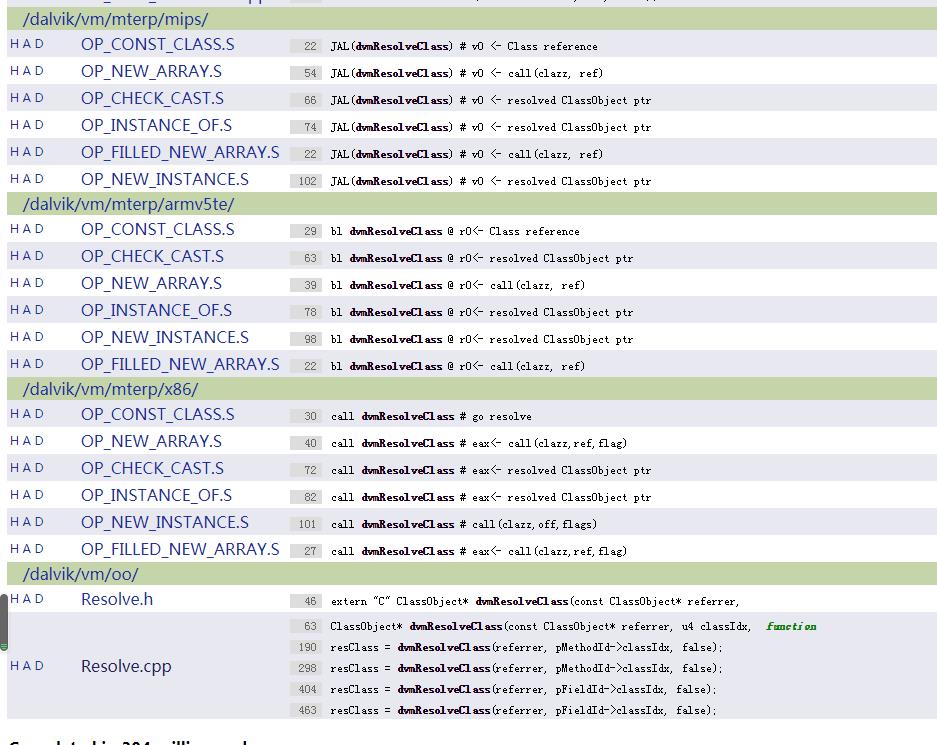
通过搜索,我们发现这个方法的调用都是在实例化的时候调用的;
HANDLE_OPCODE(OP_NEW_INSTANCE /*vAA, class@BBBB*/)
ClassObject* clazz;
Object* newObj;
EXPORT_PC();
vdst = INST_AA(inst);
ref = FETCH(1);
ILOGV("|new-instance v%d,class@0x%04x", vdst, ref);
clazz = dvmDexGetResolvedClass(methodClassDex, ref);
if (clazz == NULL)
clazz = dvmResolveClass(curMethod->clazz, ref, false);
if (clazz == NULL)
GOTO_exceptionThrown();
通过跟踪我们也会发现解释器执行到new-instance时,会触发,最终会调用到dvmResolvedClass方法;
然后我们看异常,也是在调用Utils的类 就是MainActivity.class中抛出的
那么我们跟踪MainActivity.class的初始化:
具体的应用加载的流程:
可以参考老罗的博客Android应用程序启动过程源代码分析
那我们先去看ActivityThread的源码
很快我们就发现了:

继续往下看
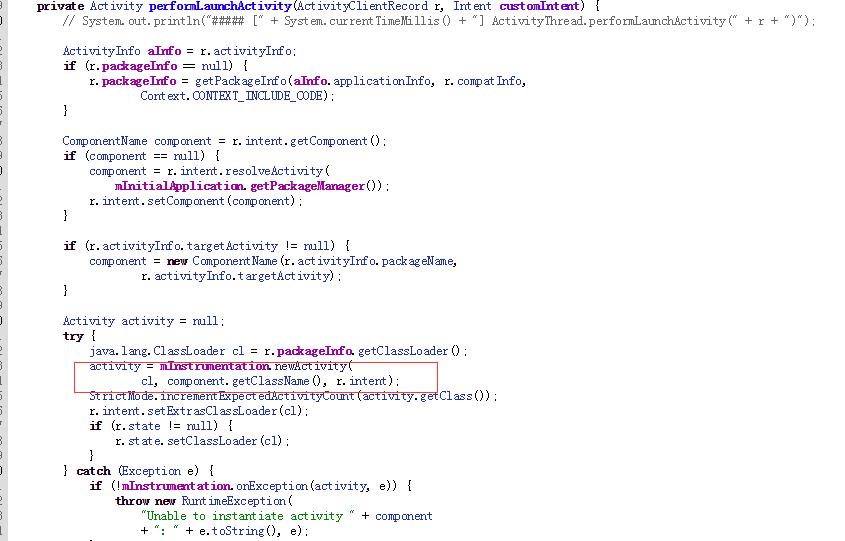
这里我们发现了activity的初始化
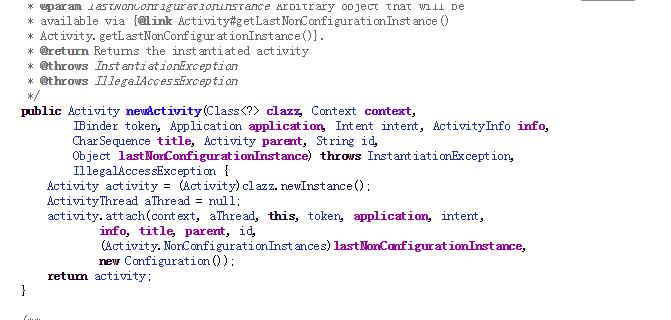
看完了整个流程,我们回归dvmResolvedClass方法
referrer是curMethod->clazz , 首先在dvmDexGetResolvedClass方法中判断是否解析过该类,很明显,该类是首次加载,所以返回结果为空,然后调用dvmFindClassNoInit方法用classloader去查找类,因为patch.dex已经在之前反射注入到了elements中,所以此时resClass不为空,此时检查MainActivity是否被打上了CLASS_ISPREVERIFIED,此时先给出结果,肯定是打上了的,进而转入到
if (referrer->pDvmDex != resClassCheck->pDvmDex && resClassCheck->classLoader != NULL)
这行代码翻译过来就是MainActivity所在的dex和Test所在的dex不是同一个且Test的类加载器不为空的情况下,就会抛出异常 “Class ref in pre-verified class resolved to unexpected implementation”,现在大家都应该清楚了这个异常具体的来源。
发现问题原因了,如何解决?
盗用腾讯bugly的一张图
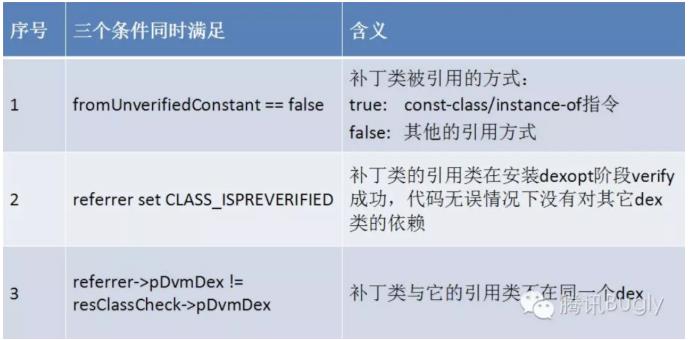
当三个条件均满足时,会抛出异常,解决方案大致上有以下四种。
- 修改fromUnverfiedConstant=true
需要通过 native hook 拦截系统方法,更改方法的入口参数,将 fromUnverifiedConstant 统一改为 true,风险大,几乎无人采用。 - 禁止dexopt过程打上CLASS_ISPREVERIFIED标记
Q-zone方案突破了此限制,但是损失了性能。 - 补丁类与引用类放在同一个dex中
Tinker等全量合成方案突破了此限制。 - 使dvmDexGetResolvedClass返回不为null,直接返回
QFix的方案,可参考这篇文章QFix探索之路—手Q热补丁轻量级方案
各个方案都有各自的优缺点。
上一篇实战我们使用的就是Q-zone方案
那么我们就分析Q-zone方案原理是在每个类的构造方法中加入一行代码,保证Hack.class在单独的dex中,选择在构造函数中进行可以不增加方法数。如下:
public class Test
public Test()
System.out.println(Hack.class);
我们从源码的角度看一下,为什么加入了这行代码,每个插入的类中都不会打上CLASS_ISPREVERIFIED了。
dexopt的过程是分为verify+optimize两个步骤进行的,对于每个类的verify+optimize方法是在verifyAndOptimizeClass方法中进行的,源码位置在:
/dalvik/vm/analysis/DexPrepare.cpp
/*
* Verify and/or optimize a specific class.
*/
static void verifyAndOptimizeClass(DexFile* pDexFile, ClassObject* clazz,
const DexClassDef* pClassDef, bool doVerify, bool doOpt)
const char* classDescriptor;
bool verified = false;
if (clazz->pDvmDex->pDexFile != pDexFile)
/*
* The current DEX file defined a class that is also present in the
* bootstrap class path. The class loader favored the bootstrap
* version, which means that we have a pointer to a class that is
* (a) not the one we want to examine, and (b) mapped read-only,
* so we will seg fault if we try to rewrite instructions inside it.
*/
ALOGD("DexOpt: not verifying/optimizing '%s': multiple definitions",
clazz->descriptor);
return;
classDescriptor = dexStringByTypeIdx(pDexFile, pClassDef->classIdx);
/*
* First, try to verify it.
*/
if (doVerify)
if (dvmVerifyClass(clazz))
/*
* Set the "is preverified" flag in the DexClassDef. We
* do it here, rather than in the ClassObject structure,
* because the DexClassDef is part of the odex file.
*/
assert((clazz->accessFlags & JAVA_FLAGS_MASK) ==
pClassDef->accessFlags);
((DexClassDef*)pClassDef)->accessFlags |= CLASS_ISPREVERIFIED;
verified = true;
else
// TODO: log when in verbose mode
ALOGV("DexOpt: '%s' failed verification", classDescriptor);
if (doOpt)
bool needVerify = (gDvm.dexOptMode == OPTIMIZE_MODE_VERIFIED ||
gDvm.dexOptMode == OPTIMIZE_MODE_FULL);
if (!verified && needVerify)
ALOGV("DexOpt: not optimizing '%s': not verified", classDescriptor);
else
dvmOptimizeClass(clazz, false);
/* set the flag whether or not we actually changed anything */
((DexClassDef*)pClassDef)->accessFlags |= CLASS_ISOPTIMIZED;
很清晰,dvmVerifyClass如果校验通过了,该clazz就会被打上CLASS_ISPREVERIFIED标记。接下来我们主要看dvmVerifyClass方法都干了什么。源码位置:/dalvik/vm/analysis/DexVerify.cpp
/*
* Verify a class.
*
* By the time we get here, the value of gDvm.classVerifyMode should already
* have been factored in. If you want to call into the verifier even
* though verification is disabled, that's your business.
*
* Returns "true" on success.
*/
bool dvmVerifyClass(ClassObject* clazz)
int i;
if (dvmIsClassVerified(clazz))
ALOGD("Ignoring duplicate verify attempt on %s", clazz->descriptor);
return true;
for (i = 0; i < clazz->directMethodCount; i++)
if (!verifyMethod(&clazz->directMethods[i]))
LOG_VFY("Verifier rejected class %s", clazz->descriptor);
return false;
for (i = 0; i < clazz->virtualMethodCount; i++)
if (!verifyMethod(&clazz->virtualMethods[i]))
LOG_VFY("Verifier rejected class %s", clazz->descriptor);
return false;
return true;
在verifyMethod中会对Method的各个字段进行验证,篇幅原因,不进行逐层源码追踪了,在verifyMethod方法中,会调用dvmVerifyCodeFlow方法,接着调用doCodeVerification,会具体分析每一条指令,执行必要的解析及验证。对于每一条指令,是调用verifyInstruction方法来验证的。verifyInstruction方法的源码位置:/dalvik/vm/CodeVerify.cpp。
在verifyInstruction中,注意这段代码。
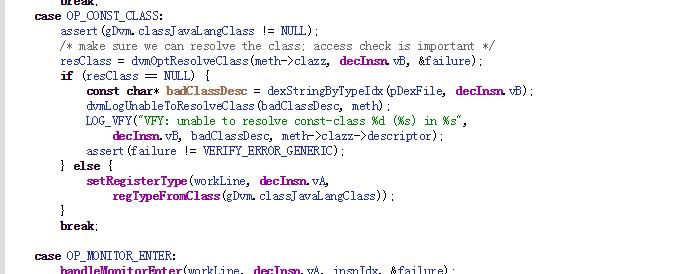
为什么要关注OP_CONST_CLASS,因为我们插入的System.out.println(Hack.class);会生成const-class的dalvik指令,可以通过dexdump或者反编译apk来查看,此时会触发dvmOptResolveClass的调用。dvmOptResolveClass函数会去查找Hack.class,由于我们的dex没有Hack.class,肯定查不到,抛异常返回,此时这个类的dvmVerifyClass过程会返回false,这个类也就没有打上CLASS_ISPREVERIFIED,而verified为false,导致也不会进行optimize过程。
值得说明的是如果类没有打上CLASS_ISPREVERIFIED,那么verify+optimize都会在类第一次加载时dvmInitClass中进行,正常情况下每个类的verify+optimize只会在安装时dexopt中进行一次,verify过程非常重,会对类的所有方法的所有指令都进行校验,如果短时间内,大量的类进行verify,耗时是比较严重的,尤其在应用刚启动的时候,有可能造成白屏;
这也是我们为什么说Qzone的修改方案很损失性能的原因;
至于我们如何插入System.out.println(Hack.class),我们可以采用ASM进行实现。实现过程注意两点:
- Application不要插入Hack.class,因为application的构造函数执行时,我们还没有注入hack.apk
- 在注入patch.dex前注入hack.apk,否则会找不到类
实战修复CLASS_ISPREVERIFIED
我使用Qzone 禁止dexopt过程打上CLASS_ISPREVERIFIED标记的方案实现修复CLASS_ISPREVERIFIED问题;
根据上面说的原理,CLASS_ISPREVERIFIED标签被打上的原因,是因为MainActivity只引用了当前Dex包内的class而导致,那么我们只需要在该Dex内除了Application的所有class中都引用一个在另外一个Dex的class即可避免打上CLASS_ISPREVERIFIED标签,这个就是Qzone的修复方案。
以上是关于热修复 笔记 第三部分 优化篇的主要内容,如果未能解决你的问题,请参考以下文章